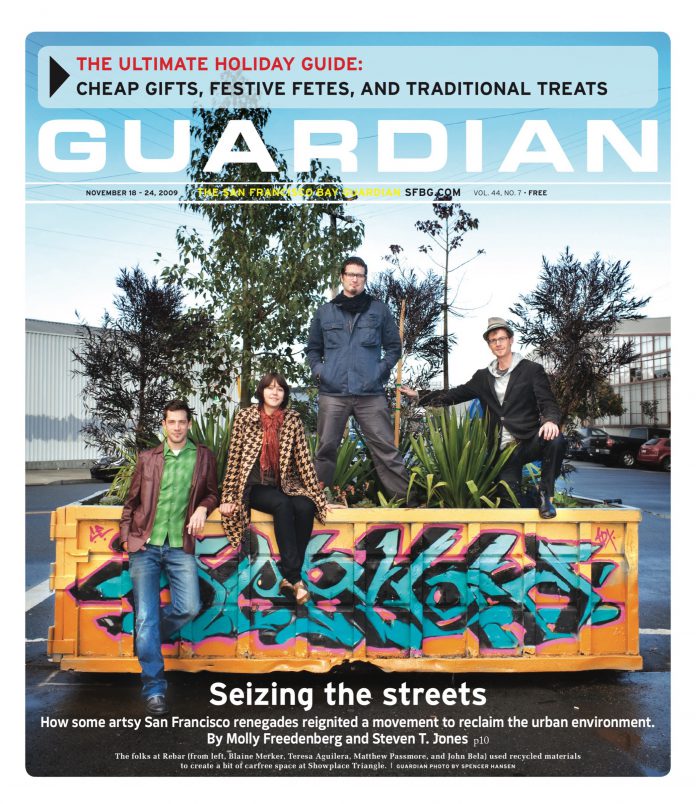arts@sfbg.com
Call it revenge of the G-funk era.
Yes, the sound that sparked a bicoastal beef and led to the murder of two rap superstars has made a roaring comeback. It invited mimicry (Kriss Kross’ 1992 "Jump" and the Notorious B.I.G.’s 1994 "Big Poppa"); scorn ("It’s the money," DJ Shadow noted with dripping sarcasm as he queued up that bleating keyboard line once more on "Why Hip Hop Sucks in ’96"); and eventually got played-out like flannel shirts and Doc Martens. But now, it has returned. British music fans, always keen on a good nickname, call it "boogie-funk," referencing an additional presence: the early 1980s computer-funk of heroes like George Clinton and Dirty Mind-era Prince. The two scenes and sounds — 1980s post-disco funksters in their outrageously gussied-up costumes and processed hair, and 1990s West Coast hoo-bangers paying homage to their childhood with P-Funk and Isley Brothers samples — seem entirely dissimilar. But Damon Riddick, known as Dam-Funk, bridges the gap.
"I’m not a fad," says Dam-Funk. "I didn’t discover this six months ago. I’ve been doing this for a long time. It’s real and sincere. It’s not fake."
With his straightened windswept hair and imposing mustached visage, Dam-Funk looks like a funk lord from the early ’80s — a potential target for Dave Chappelle. But he’s not being ironic. On his new album Toeachiszown (Stones Throw), as synthesized melodies waft about angelically, when he sings the title words of "The Sky is Ours" in a slight falsetto, his emotional sincerity is palpable.
Dam-Funk is both badass L.A. dude and sensitive soul. He misses the "boogie-funk" era, and the svelte keyboard-and-bass-bottom of Mtume’s 1982 "Juicy Fruit" and the Dazz Band’s 1983 "Joystick." It briefly flourished in early-’80s black communities before other forms like hip-hop, house music, smooth jazz, and New Jack Swing buried it. Mostly forgotten by scholars or inaccurately mixed up with disco or house, the "boogie-funk" period rarely drew serious attention until recently.
"What I’m trying to do is further the love of groups like Slave, Aura, One Way, Mtume," says Dam-Funk. "When Run-DMC dropped with "It’s Like That" [in 1983], it was over. Everything went hard, masculine, balls-out, throw your fists in the air, that kind of thing. Now that we got [past] the giddy excitement over that aspect of hip-hop, people are discovering the beautiful chords. It’s okay to do chords that feel good inside."
Dam-Funk’s hip-hop edge comes from playing keyboards for Allfromthai, Mack 10, and other G-funk artists in the late-1990s. His most memorable session was playing on Westside Connection’s 1998 "Let It Reign." "It was crazy to walk in the studio with [Ice] Cube on one end, Mack 10 on the other end with the red shoelaces, WC over at the other end, and there’s about 20 other dudes in the studio, with the weed guy showing up," he laughs. "And cats were so respectful, man. Nobody was really tripping. Everyone looks at those guys like they were hoodlums. But they weren’t. They were just really into music."
Earlier that decade, the man then known as Damon Riddick apprenticed as a teenager with Leon Sylvers, the super-producer behind the Sylvers (1975’s "Boogie People") and black radio hits like Shalamar’s 1979 "The Second Time Around" and the Whispers’ "It’s A Love Thing" (1981). He recorded a few demos with Sylvers. "It didn’t turn into anything, but I still kept in touch with him," Dam-Funk says. "He taught me a lot about production technique."
Dam-Funk’s L.A. swagger pops up in his song titles ("Hood Pass Intact" and "Killdat a.k.a. Killdatmuthafucka") and his postmodern (or post-boogie) approach to early-’80s computer funk. He weaves dense instrumentals that sprawl for up to eight minutes, but tosses in enough slight chord changes to maintain interest. And unlike his boogie-funk predecessors, who maddeningly flitted between brilliant dance floor ragers and sappy slow dance ballads, he sticks to a certain tempo and mines it.
At two-and-a-half-hours and two CDs long, Toeachizown is remarkably inventive. Its spacey, bedazzled vibe rarely changes, but it doesn’t bore, either; it’s like a lovely waltz. On "Keep Lookin’ 2 The Sky," Dam-Funk uses audioprocessing to chant over ascendant synth lines, creating visions of a computer-manned rocketship. "10 West," like so many of the tracks, is quiet and balletic, drawing inspiration from electronic fusion pioneers like Paul Hardcastle.
If G-funk launched Dam-Funk’s career, then Toeachizown launches him into the heavens. "The sounds [are] progressive, hood, fantasy, all those things mixed up," he explains. "1982-slash-2022."
DAM-FUNK
Nov. 24, 9 p.m., $22-25
With Warren G, U-N-I
The Independent
628 Divisadero, SF
(415) 771-1421

